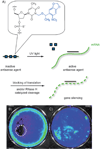Principles and applications of the photochemical control of cellular processes
- PMID: 19911402
- PMCID: PMC3768145
- DOI: 10.1002/cbic.200900529
Principles and applications of the photochemical control of cellular processes
Figures








References
-
- Casey JP, Blidner RA, Monroe WT. Mol. Pharm. 2009;6:669–685. - PubMed
- Young DD, Deiters A. Org. Biomol. Chem. 2007;5:999–1005. - PubMed
- Tang X, Dmochowski IJ. Mol. Biosyst. 2007;3:100–110. - PubMed
- Mayer G, Heckel A. Angew. Chem. 2006;118:5020–5042. Angew. Chem. Int. Ed. 2006, 45, 4900–4921.
- Furuta T, Noguchi K. Trends Anal. Chem. 2004;23:511–519.
- Curley K, Lawrence DS. Curr. Opin. Chem. Biol. 1999;3:84–88. - PubMed
- Adams SR, Tsien RY. Annu. Rev. Physiol. 1993;55:755–784. - PubMed
- Lee HM, Larson DR, Lawrence DS. ACS Chem. Biol. 2009;4:409–427. - PMC - PubMed
-
- Kaplan JH, Forbush B, Hoffman JF. Biochemistry. 1978;17:1929–1935. - PubMed
-
- Zhu Y, Pavlos CM, Toscano JP, Dore TM. J. Am. Chem. Soc. 2006;128:4267–4276. - PubMed
-
- Momotake A, Lindegger N, Niggli E, Barsotti RJ, Ellis-Davies GC. Nat. Methods. 2006;3:35–40. - PubMed
Publication types
MeSH terms
Substances
Grants and funding
LinkOut - more resources
Full Text Sources
Other Literature Sources

